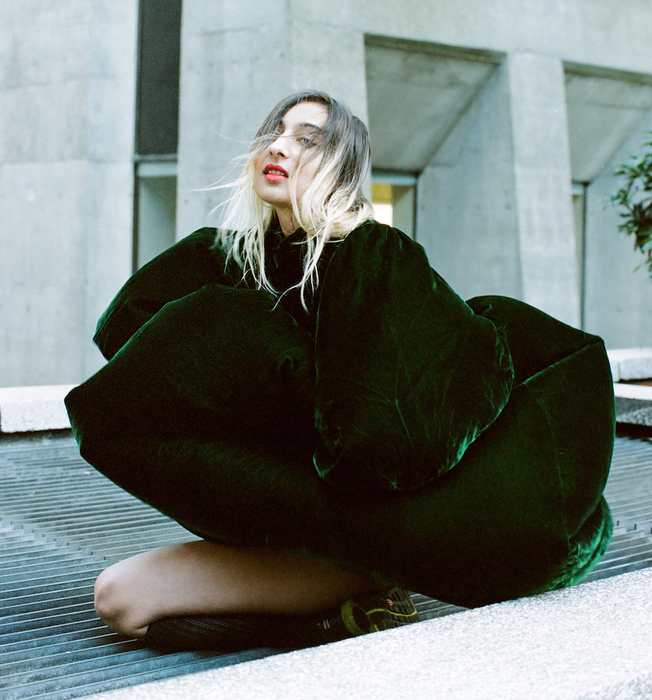Purveyor of: Silken electronic curves and swirls, gilded with pulsing beats.
File next to: Petra Glynt, Grimes, Braids
Playing: WL17 Night 3, Sunday Feb. 19 @ The Garrison. Get tickets here!
Rebecca Fin Simonetti is a multidisciplinary creator now residing in New York, with roots in the Toronto arts community. Her musical endeavour FIN is a halting and haunted electronic manifestation, with minimal dance and weirdo trip-hop colouring. Wavelength’s Adam Bradley spoke with Rebecca about her new record and her artistic exploration of textile factories in southeast China.
So you’ve got a new record coming down the pipe called ICE PIX, put together while at an artist residency in Vermont. Is it grounded in earlier material or did you conjure up a bunch of new stuff?
About half the songs were written during the residency — like “Doghead” and “Autobody,” whereas “Chickenshit” and “In Silver” I had recorded previously.
What’s the root of the record? Does it have an intentional, underlying message or do the tracks stand as themselves? Any major themes that emerge?
Each song came about through its own need and any cohesion emerged organically. I think that there are some landmarks thematically: narratives about technology, isolation, repression and euphoria.
I read that you’re a fan of the poet Ted Hughes, and spent a lot of time with his work while recording the record. You mentioned it inspired some of the tracks? In which way do you mean?
My initial entry into his work came through my interest in [Sylvia] Plath’s work and life. I’ve been devoted to her work ever since I was a teen goth… I can recite a few pieces from memory. Right before I went to the Vermont Studio Center, I had read two of her biographies back-to-back, which lead me to reading Ted Hughes’ poetry for context.
Ted Hughes is this very powerful masculine and enigmatic figure. He emerges as a sort of tragic villain in relation to Plath’s biography. My song “The Colossus” is written from Plath’s perspective, looking at both Hughes and Plath’s father. Plath has a poem by the same name, which uses the overpowering structure of the colossus as a metaphor for patriarchal dominance, which she narrates with a mix of idolization and misandry.
Visual art takes up a large amount of your creative time, it seems. How do you balance being a visual artist and musician? Do you define time to work on each or is it more of a “when the mood strikes” kind of arrangement?
I don’t really balance it… [laughs] I am always over-stretched. If I have specific deadlines, I prioritize work based on urgency. Otherwise, I work based on a feeling. Some things can only be expressed with music. I wish I had two lives to each devote wholly to each practice.
You’re formerly of Toronto, and still spend a fair amount of time here. How do you engage with multiple communities on various artistic levels in terms of setting up shows and having reasons to travel?
When I can, I like to set up shows down in New York for my Canadian friends. Like last year, Bile Sister [Toronto] came down to play with Bunny Michaels [NYC]. Vanessa Rieger did live projections for that show. Alternately, I’ve helped friends down here set up shows in Toronto or Montreal. It’s important to cross-pollinate across geography.

In 2012 on a trip to southeastern China, you worked on an art piece where you walked through a sweatshop and sang “Part of Your World” from The Little Mermaid, as workers ignored your presence. Pretty arresting stuff. Can you talk about that experience and how you arranged it?
Yeah, executing that piece was both humiliating and humbling. My humiliation is key to the work. In terms of logistics, I arranged to get into the factories by trying a bunch of schemes until something worked. On a few occasions, I set up meetings to “tour” factories under the false pretext that I was a Canadian fashion designer looking to hire textile workers. In those cases, I would just cold-call local factories until someone obliged. I’d also met a few English-speaking locals who were working in admin at the residency, and through them I got connected to factories owned by their friends or family.
One of my first performances was during a government-led tour of a silk factory. We were restricted to particular rooms, and were accompanied at all times — but in that particular case, we were allowed to have cameras. On other occasions — like when I set up a “tour” through a cold call — the factory owner would sometimes change their mind when they saw the camera. Depending on how things felt, I’d either push or not.
Most factories were unimaginably hot and humid. There is one factory that I didn’t get a chance to film in, in which the volume of the machinery was deafening. In the textile factories, the workers were mostly women. Sometimes they would have young children at their sides, either sitting idly or learning the trade. The government-approved tour looked very different from factories I found through cold-calling or networking with the locals at Sunhoo.
FIN plays the final night of Wavelength Music Festival 17, Sunday February 19 at The Garrison.
— Interview by Adam Bradley

